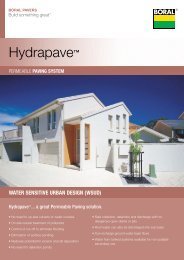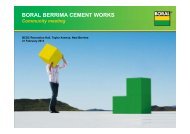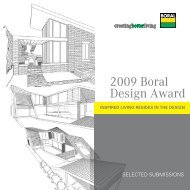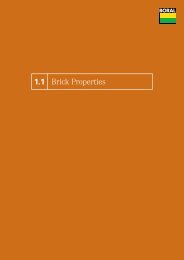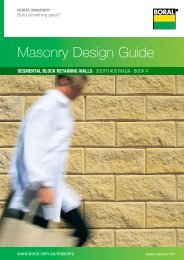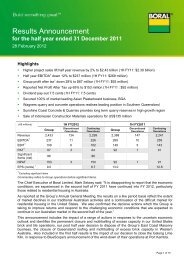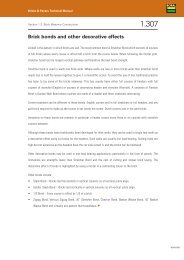Create successful ePaper yourself
Turn your PDF publications into a flip-book with our unique Google optimized e-Paper software.
The energy life cycle<br />
never before have new homes been built so responsively to our landscape,<br />
climate and lifestyles.<br />
an energy-wise home or building will use the best<br />
combination of sustainable building considerations<br />
such as site orientation, wall and ceiling insulation,<br />
ventilation and materials to reduce energy<br />
consumption and in turn greenhouse gas emissions.<br />
it’s all about taking a long-term view on our impact<br />
on the environment. From the initial sourcing and<br />
manufacture of materials to the need for ongoing<br />
maintenance and temperature control, it’s the<br />
efficient use of energy over the lifespan of a building<br />
that counts.<br />
together with good design principles, bricks can<br />
help you take advantage of the weather when it’s<br />
hot or cold. When around 38 per cent of energy use<br />
in australian homes is directed toward artificial<br />
heating and cooling*, this is serious long-term value.<br />
* http://www.yourhome.gov.au/technical/pubs/fs61.pdf<br />
Home Energy Use, Baseline Energy Estimates 2008<br />
tiP Conserve energy over the<br />
long term by using a strong, longlasting<br />
and non-toxic material.<br />
<strong>Boral</strong> <strong>Bricks</strong> | Victoria, tasmania & South australia 3<br />
Energy efficient design<br />
there are four factors crucial to the energy<br />
performance of your home:<br />
orientation<br />
Site orientation or the position of a building relative to the sun provides the<br />
opportunity to take advantage of the naturally available energy. With northerly<br />
living areas the use of extended eaves will block the higher summer sun while<br />
allowing the low winter sun to enter your home.<br />
inSulation<br />
Ceiling insulation acts as a barrier to heat flow and is essential to providing<br />
year-round comfort. in regards to walls, this is where high thermal mass<br />
double brick cavity wall construction comes to the fore.<br />
Ventilation<br />
Cross-ventilation, with openings on both sides of a home, is the best way of<br />
cooling naturally. Fresh breezes will circulate better in open plan living spaces<br />
however internal walls are still required for their thermal mass, helping moderate<br />
temperatures. Vents should also be installed in the roof space to help<br />
regulate air flow year-round.<br />
thermal maSS<br />
materials with high thermal mass, or ability to absorb and store heat energy,<br />
are important in most australian climates where there is a need to average<br />
out temperature extremes. the density of clay bricks effectively delays the<br />
flow of heat through a wall by as much as 8 to 10 hours, producing a<br />
warmer house in winter and a cooler house in summer.<br />
diagram: think Brick australia




